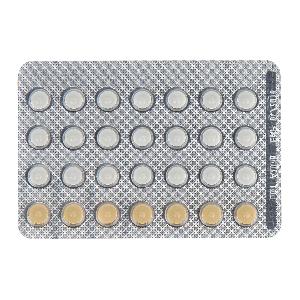Lillow Dosage
Generic name: LEVONORGESTREL 0.15mg, ETHINYL ESTRADIOL 0.03mg;
Dosage form: tablets
Drug class: Contraceptives
Medically reviewed by Drugs.com. Last updated on Dec 7, 2022.
To achieve maximum contraceptive effectiveness, Lillow® (levonorgestrel and ethinyl estradiol tablets, USP 0.15 mg/0.03 mg) must be taken exactly as directed and at intervals not exceeding 24 hours.
The dosage of Lillow® is one white tablet daily for 21 consecutive days, followed by one yellow inert tablet daily for 7 consecutive days, according to prescribed schedule.
It is recommended that tablets be taken at the same time each day, preferably after the evening meal or at bedtime.
During the first cycle of medication, the patient is instructed to begin taking Lillow® on the first Sunday after the onset of menstruation. If menstruation begins on a Sunday, the first tablet (white) is taken that day. One white tablet should be taken daily for 21 consecutive days, followed by one yellow inert tablet daily for 7 consecutive days. Withdrawal bleeding should usually occur within three days following discontinuation of white tablets and may not have finished before the next pack is started. During the first cycle, contraceptive reliance should not be placed on Lillow® until a white tablet has been taken daily for 7 consecutive days and a nonhormonal back-up method of birth control should be used during those 7 days. The possibility of ovulation and conception prior to initiation of medication should be considered.
The patient begins her next and all subsequent 28-day courses of tablets on the same day of the week (Sunday) on which she began her first course, following the same schedule: 21 days on white tablets—7 days on yellow inert tablets. If in any cycle the patient starts tablets later than the proper day, she should protect herself by using another method of birth control until she has taken a white tablet daily for 7 consecutive days.
When the patient is switching from a 21-day regimen of tablets, she should wait 7 days after her last tablet before she starts Lillow®. She will probably experience withdrawal bleeding during that week. She should be sure that no more than 7 days pass after her previous 21-day regimen. When the patient is switching from a 28-day regimen of tablets, she should start her first pack of Lillow® on the day after her last tablet. She should not wait any days between packs. The patient may switch any day from a progestin-only pill and should begin Lillow® the next day. If switching from an implant or injection, the patient should start Lillow® on the day of implant removal or, if using an injection, the day the next injection would be due. In switching from a progestin-only pill, injection or implant, the patient should be advised to use a nonhormonal back-up method of birth control for the first 7 days of tablet-taking.
If spotting or breakthrough bleeding occurs, the patient is instructed to continue on the same regimen. This type of bleeding is usually transient and without significance; however, if the bleeding is persistent or prolonged, the patient is advised to consult her physician. Although the occurrence of pregnancy is highly unlikely if Lillow® is taken according to directions, if withdrawal bleeding does not occur, the possibility of pregnancy must be considered. If the patient has not adhered to the prescribed schedule (missed one or more tablets or started taking them on a day later than she should have), the probability of pregnancy should be considered at the time of the first missed period and appropriate diagnostic measures taken before the medication is resumed. If the patient has adhered to the prescribed regimen and misses two consecutive periods, pregnancy should be ruled out before continuing the contraceptive regimen.
For additional patient instructions regarding missed pills, see the “WHAT TO DO IF YOU MISS PILLS” section in the DETAILED PATIENT LABELING below.
Any time the patient misses two or more white tablets, she should also use another method of contraception until she has taken a white tablet daily for seven consecutive days. If the patient misses one or more yellow tablets, she is still protected against pregnancy provided she begins taking white tablets again on the proper day.
If breakthrough bleeding occurs following missed white tablets, it will usually be transient and of no consequence. While there is little likelihood of ovulation occurring if only one or two white tablets are missed, the possibility of ovulation increases with each successive day that scheduled white tablets are missed.
Lillow® may be initiated no earlier than day 28 postpartum in the non-lactating mother or after a second trimester abortion due to the increased risk for thromboembolism (see CONTRAINDICATIONS, WARNINGS, and PRECAUTIONS concerning thromboembolic disease). The patient should be advised to use a nonhormonal back-up method for the first 7 days of tablet taking. However, if intercourse has already occurred, pregnancy should be excluded before the start of combined oral contraceptive use or the patient must wait for her first menstrual period.
In the case of first trimester abortion, if the patient starts Lillow® immediately, additional contraceptive measures are not needed. It is to be noted that early resumption of ovulation may occur if Parlodel® (bromocriptine mesylate) has been used for the prevention of lactation.
More about Lillow (ethinyl estradiol / levonorgestrel)
- Check interactions
- Compare alternatives
- Reviews (36)
- Drug images
- Side effects
- During pregnancy
- Drug class: contraceptives
Patient resources
Other brands
Vienva, Aviane, Lutera, Altavera, ... +49 more
Professional resources
Other brands
Vienva, Aviane, Lutera, Altavera, ... +47 more
Related treatment guides
Further information
Always consult your healthcare provider to ensure the information displayed on this page applies to your personal circumstances.

